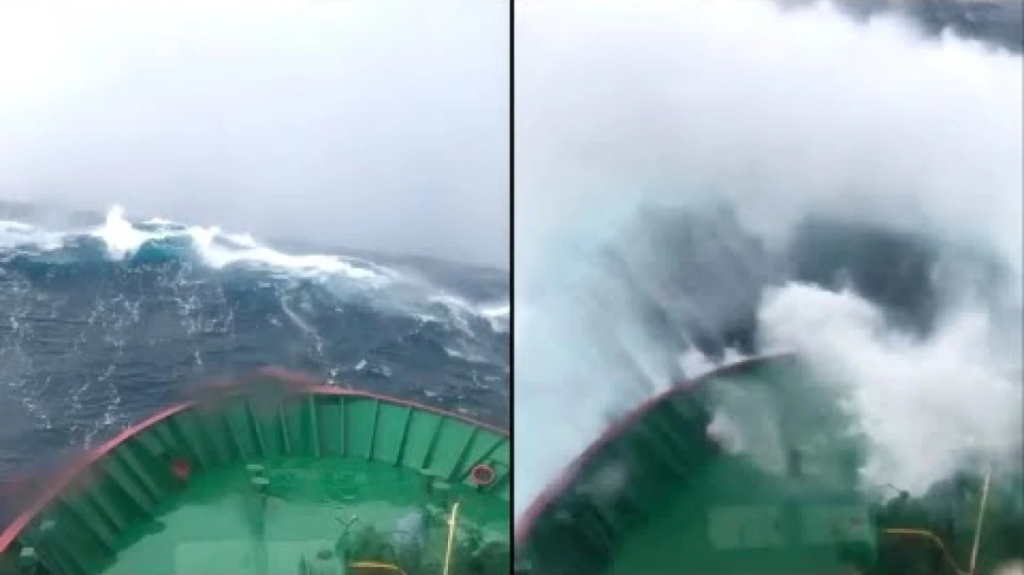Imagine sailing the vast expanse of the ocean, the calm waters gently rocking your boat, when suddenly, without warning, a colossal wave rises from the depths, overwhelming everything in its path. These monstrous mountains of water, known as trap waves, monster waves or giant waves, have long fascinated sailors, scientists and storytellers with their sheer power and enigmatic nature.
Rogue waves, also referred to as freak waves or monster waves, are massive and extremely large waves that occur in the open ocean. Unlike ordinary waves, which are usually the result of wind or seismic activity, rogue waves appear seemingly out of nowhere, often without any discernible cause.
The first and most famous recording of the phenomenon was actually the Draupner wave, a 25.6 meter “monster” recorded in the North Sea on January 1, 1995. But despite the observations, experts still don’t know how often these waves occur or if they can predict them.
Unpredictability and risk
So one of the most puzzling aspects of rogue waves is their unpredictable nature. They can appear suddenly, even in relatively calm seas, and disappear just as quickly, leaving little evidence of their existence. This unpredictability is a significant danger to mariners, as ships may not have sufficient time to prepare or react to the sudden attack of such a large wave.
These giant waves, in fact, have been involved in numerous maritime disasters throughout history, with ships of all sizes falling victim to their immense power. From ancient sailors telling stories of towering waves swallowing entire fleets to modern cruise ships facing unexpected waves, the threat posed by rogue waves remains a constant concern for those who cross the world’s oceans.
The biggest waves on record
On November 17, 2020, a buoy anchored in 45 meters of water somewhere in the Pacific Ocean, 7 kilometers off Ucluelet, Vancouver Island, recorded a solitary 17.6 meter wave among surrounding waves of about 6 meters.
When the wave detection was revealed to the public in February 2022, a scientific paper and several news outlets dubbed the event “the most extreme wave phenomenon ever recorded” and a “once in a millennium” event, claiming that at about three times the height of the waves around it, the Ucluelet wave set a record as the most extreme wave ever recorded at the time.

The Ucluelet incident, however, caused controversy. Analysis of scientific articles dealing with rogue wave events from 2005 onwards revealed that claims about the nature of the wave being a record and the rarity of the wave were inaccurate.
The paper Oceanic rogue waves (https://arxiv.org/abs/1501.03370) specifically mentions an event in the Black Sea in 2004, which was much more extreme than the Ucluelet wave. There the Datawell Waverider recorded a wave that was 3.91 times larger. Also other documents conclude that in 2006 a wave of 21 meters appeared in the same area.
More recently, on November 29, 2022, a wave struck the Viking cruise ship Viking Polaris while en route to Ushuaia, Argentina. One person died, four others were injured and the ship’s planned voyage to Antarctica was cancelled.
Also on January 20, 2024, one or more giant waves hit the United States Army Roi-Namur Proving Ground on Kwajalein Atoll in the Marshall Islands, smashing through the doors of a dining hall, knocking several people off their feet, causing moderate to severely damaging the dining hall, the Outrigger Bar and Grill, the Chapel and the Tradewinds Theatre, and leaving parts of the island, including the car complex, under water.
The waves penetrated 91 meters into the interior of the island and were probably between 8.8 and 12.2 meters high. The flooding of the dining room of one of the areas hit was videotaped.

he science behind giant waves
Despite decades of research, the exact mechanisms that cause these waves remain elusive. A prevailing theory holds that rogue waves are the result of inductive interference, where smaller waves align in such a way that their crests coincide, amplifying their combined height. Another theory suggests that these waves may be formed by non-linear phenomena, such as conformational instability, which can cause waves to rapidly increase in size under certain conditions.
Recent advances in oceanography and satellite technology have provided new insights into the behavior of giant waves unrelated to tsunamis. Satellite observations have revealed that spacer waves are more common than previously thought, occurring with surprising frequency across the world’s oceans.
These observations also showed that giant waves tend to cluster in certain areas known for their extreme ocean conditions, such as the Agulhas Current off the coast of South Africa and the notorious waters of the North Atlantic.
Mitigation of risks
Although the unpredictability of waves is a significant challenge, efforts are being made to better understand and mitigate the risks associated with these formidable phenomena. Advanced modeling techniques and improved forecasting methods help identify conditions conducive to the formation of storm surges, allowing ships to avoid high-risk areas whenever possible.
Yet for all our progress, the ocean still seems to remain an untamed frontier, where the forces of nature reign supreme and the specter of wandering waves dominates the imaginations of sailors and scientists.







